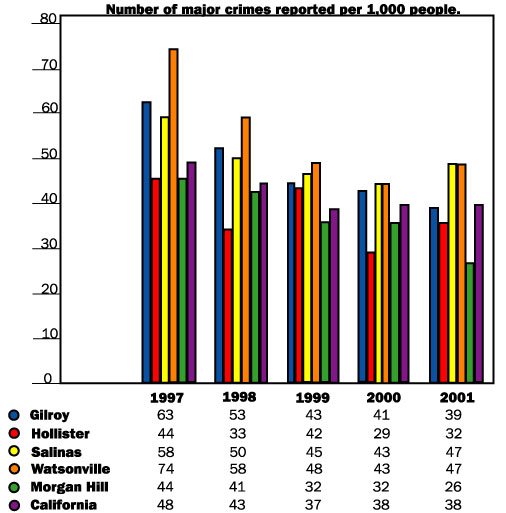GILROY
– As the economy continues to plunge and Gilroy unemployment
rates reach their highest point in six years, local residents can
expect more cases of robbery and theft on Gilroy streets, according
to police.
GILROY – As the economy continues to plunge and Gilroy unemployment rates reach their highest point in six years, local residents can expect more cases of robbery and theft on Gilroy streets, according to police.
A recently released report by the Gilroy Police Department comparing crime in Gilroy, Morgan Hill, Hollister, Salinas, Watsonville and California as a whole shows that while Gilroy’s rate for major crime continued to drop in 2001, theft crimes increased.
“This rise in robberies and thefts is something we are seeing across the board and something that you expect when the economy is bad,” said GPD Chief Gregg Giusiana, who oversaw the department’s $15 million budget in 2001. “Last year the thefts we saw were mostly street things where people were not getting a lot of money. It’s not like we’ve had a chain of liquor store or bank robberies – people are just trying to get money, fast.”
Gilroy saw a 44-percent increase in robberies in 2001, while three of the other four cities in the report along with the state also reported increases in robberies during 2001. Hollister reported the highest increase at 63 percent; Salinas was the only city not to see a rise in robberies.
But those numbers can be deceiving. While Gilroy’s rate for robbery per 1,000 citizens rose from .87 in 2000 to 1.18 in 2001 – 13 robberies – Salinas’ rate remained the highest of all the cities even though it dropped from 2.97 robberies per 1,000 citizens in 2000 to 2.69 in 2001.
“You need to be careful when you look at these statistics,” said Phylis Ward, the GPD’s crime analyst who compiled the department’s seventh annual five-city crime report. “The population numbers are so low in many of these cities that one case can throw the numbers off quite a bit.”
Unemployment rates could also have skewed those numbers because of the tight relationship between the economy and crime, Ward said.
Gilroy’s unemployment rate more than doubled from 3.4 percent in 2000 to 7.4 percent in 2001 – the second largest increase of any of the five cities – with Morgan Hill’s unemployment increasing from 1.5 to 3.5 percent. Salinas was the only city to record a decrease in unemployment, while Watsonville’s and Hollister’s rates remained higher than Gilroy’s at 12.8 and 10.5 percent, respectively. Unemployment in California grew from 4.9 percent in 2000 to 5.3 percent in 2001.
But even with the poor economy and the rise in robberies Gilroy did improve its overall crime rate, something it has done continuously since 1997.
Gilroy and Morgan Hill were the only cities of the five to experience a reduction in major crimes – which includes homicide, forcible rape, robbery, aggravated assault, burglary, larceny, motor vehicle theft and arson – the state saw no change in such crimes.
In 2001, Gilroy’s crime rate dropped two crimes per 1,000 citizens to 39 crimes per 1,000 people. It now ranks third among the five cities and just one crime per 1,000 citizens below the state average. Gilroy’s major crime rate in 1997 was second to only Watsonville at 63 crimes per 1,000 Gilroyans.
“This shows the effectiveness of our police department over the past few years and our commitment to keep the officer-citizen ratio up to par,” said Mayor Tom Springer. “We can’t let the economic downturn decide our city’s fate, we need to keep giving the PD resources and prosecute at the highest level.”
Gilroy currently has 1.5 police officers for every 1,000 citizens, which is about average for the state, according to Giusiana. But it is the GPD’s “proactive” philosophy in getting criminals off of Gilroy’s streets that Springer attributes to the department’s recent success.
In 2001, Gilroy arrested 7 percent of its population, more than any of the other five cities or the state. And the 2,688 total arrests by the GPD in 2001 were second only to Salinas – a city with more than three times Gilroy’s population – which made 5,608 arrests.
“Some other communities might let their criminals off easy or not prosecute to the highest level,” Springer said. “But our department has made a point to seek out the criminals, and now it looks like they might be fleeing to some other cities that are not as tough – that’s fine with us.”
Although the numbers show the city with an infamous reputation for crime less than a decade ago is cleaning up its streets, Giusiana doesn’t want to pat Gilroy on the back quite yet. He says the department is currently trying to curb the theft increase, using deterrent methods such as improving street lighting.
“It’s not our goal to meet any rate or beat any other city but to keep all of our rates as low as possible,” Giusiana said. “We use this report to monitor our progress and watch for trends and areas we need to address, and we realize it will be tough if the economy stays how it is.
“The only thing we know for sure from this report is that Gilroy is a much safer place to live and work than it was 10 years ago.”















